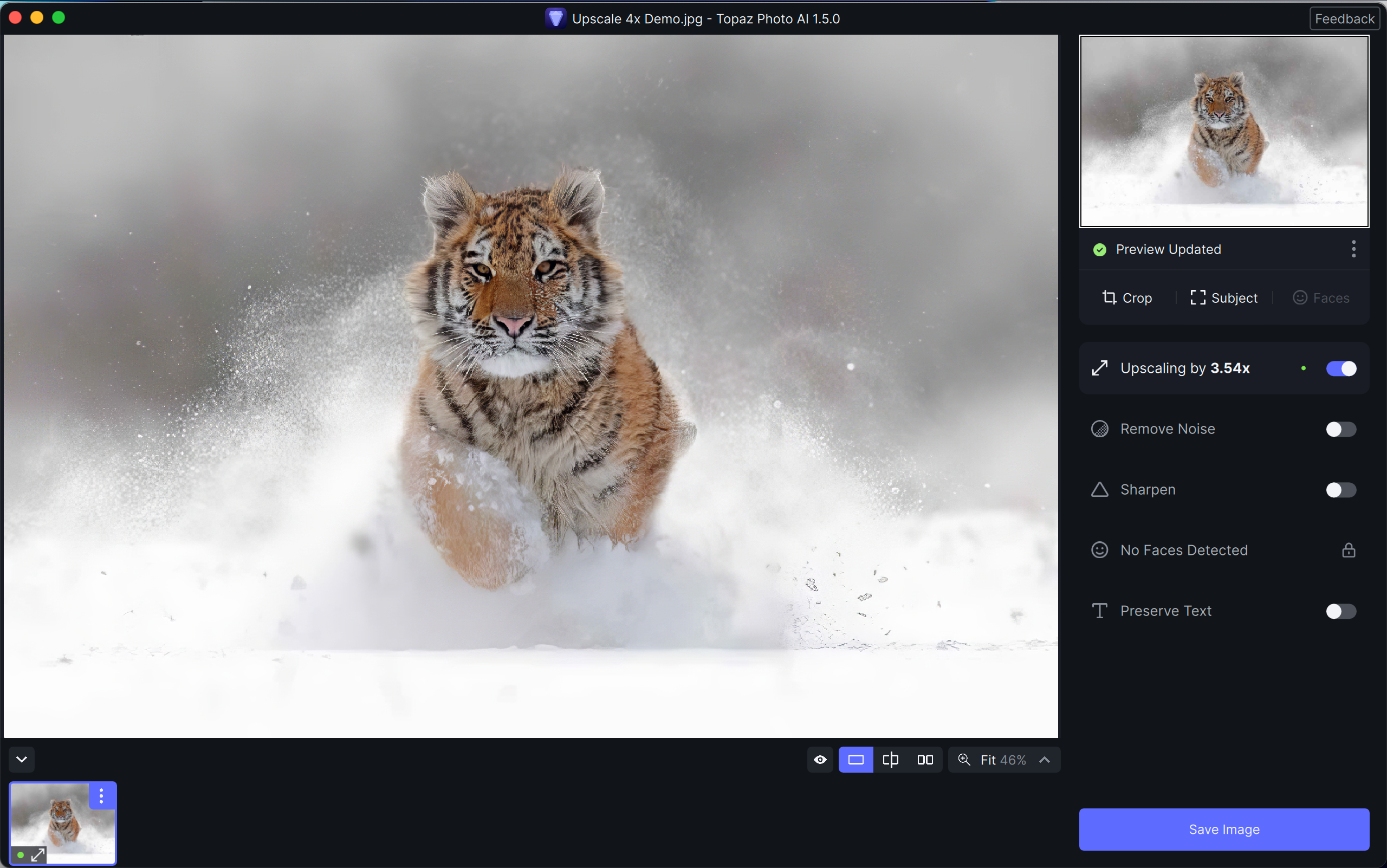Topaz Photo AI: Complete Buyer's Guide
Premium AI upscaling specialist for professional design workflows
Topaz Photo AI positions itself as the premium AI upscaling specialist for professional design workflows, delivering enterprise-quality image enhancement through specialized AI models at mid-market pricing.
Market Position & Maturity
Market Standing
Topaz Photo AI occupies a specialized premium position within the AI image upscaling market, competing primarily with Gigapixel AI and Adobe's upscaling capabilities while maintaining distinct technical advantages in surgical enhancement applications [48][49][53].
Company Maturity
The company demonstrates operational maturity through established pricing models and customer base, though specific market share data requires verification.
Industry Recognition
Industry recognition remains limited to user communities rather than formal analyst validation, though customer success evidence validates technical capabilities in specialized applications.
Longevity Assessment
Business model stability emerges through perpetual licensing: The $199 perpetual license with $99/year renewal model [47][54] provides revenue predictability while addressing customer concerns about subscription fatigue.
Proof of Capabilities
Customer Evidence
Customer success evidence reveals clear patterns based on use case alignment, with archival remediation projects demonstrating the strongest ROI validation through documented cases of organizations repurposing thousands of previously unusable images [53].
Quantified Outcomes
Quantified performance advantages include measurable improvements: 600% upscaling capability substantially outperforms Adobe Photoshop's 2x limitations [48][49], while noise reduction capabilities demonstrate superior performance compared to Lightroom AI Denoise [48].
Case Study Analysis
Eclipse photography case studies document successful 4K upscaling of previously unusable low-resolution shots [53], while wildlife photographers report high recovery rates of motion-blurred subjects using the software's five AI noise-reduction models [45][51].
Market Validation
Market validation appears through adoption patterns: Some organizations report repurposing significant portions of their image libraries through Topaz Photo AI implementation, though specific ROI percentages require third-party verification [45][51].
Competitive Wins
Independent testing confirms superior texture retention versus Gigapixel AI at 4x magnification [53], providing competitive validation for specialized enhancement workflows.
Reference Customers
Ultimate Exposures studio's implementation of 'AI oversight' protocols illustrates successful enterprise adoption, though this required developing quality control processes to prevent over-processing [45][51].
AI Technology
Topaz Photo AI's technical foundation centers on four specialized AI models that deliver measurable performance advantages over traditional methods [46][49].
Architecture
The software's core architecture focuses on surgical enhancement capabilities through dedicated models for resolution enhancement, noise reduction, sharpening, and face recovery, creating a specialized toolkit for professional image restoration workflows.
Primary Competitors
Topaz Photo AI competes primarily within the premium solutions segment against Gigapixel AI and Adobe's upscaling capabilities [48][49][53].
Competitive Advantages
Competitive advantages center on specialized enhancement capabilities: 600% upscaling while preserving texture detail substantially outperforms Adobe Photoshop's 2x limitations [48][49], while noise reduction capabilities demonstrate superior performance compared to Lightroom AI Denoise [48].
Market Positioning
Market positioning reveals strategic focus: The software lacks generative capabilities increasingly expected in professional tools—no sky replacement or AI content generation features available in Luminar Neo or Adobe Firefly [52].
Win/Loss Scenarios
Win/loss scenarios depend on use case alignment: Teams requiring predictable outcomes for high-volume processing benefit from Topaz's consistency [39][50], while organizations needing integrated content creation alongside enhancement achieve better workflow efficiency with Adobe Creative Cloud or Luminar Neo [52].
Key Features

Pros & Cons
Use Cases
Pricing
Featured In Articles
Comprehensive analysis of AI Upscaling Tools for AI Design for AI Design professionals. Expert evaluation of features, pricing, and implementation.
How We Researched This Guide
About This Guide: This comprehensive analysis is based on extensive competitive intelligence and real-world implementation data from leading AI vendors. StayModern updates this guide quarterly to reflect market developments and vendor performance changes.
57+ verified sources per analysis including official documentation, customer reviews, analyst reports, and industry publications.
- • Vendor documentation & whitepapers
- • Customer testimonials & case studies
- • Third-party analyst assessments
- • Industry benchmarking reports
Standardized assessment framework across 8 key dimensions for objective comparison.
- • Technology capabilities & architecture
- • Market position & customer evidence
- • Implementation experience & support
- • Pricing value & competitive position
Research is refreshed every 90 days to capture market changes and new vendor capabilities.
- • New product releases & features
- • Market positioning changes
- • Customer feedback integration
- • Competitive landscape shifts
Every claim is source-linked with direct citations to original materials for verification.
- • Clickable citation links
- • Original source attribution
- • Date stamps for currency
- • Quality score validation
Analysis follows systematic research protocols with consistent evaluation frameworks.
- • Standardized assessment criteria
- • Multi-source verification process
- • Consistent evaluation methodology
- • Quality assurance protocols
Buyer-focused analysis with transparent methodology and factual accuracy commitment.
- • Objective comparative analysis
- • Transparent research methodology
- • Factual accuracy commitment
- • Continuous quality improvement
Quality Commitment: If you find any inaccuracies in our analysis on this page, please contact us at research@staymodern.ai. We're committed to maintaining the highest standards of research integrity and will investigate and correct any issues promptly.